Comprehensive analysis of sialylation-related genes and construct the prognostic model in sepsis
- PMID: 39103477
- PMCID: PMC11300640
- DOI: 10.1038/s41598-024-69185-x
Comprehensive analysis of sialylation-related genes and construct the prognostic model in sepsis
Abstract
Sepsis, a life-threatening syndrome, continues to be a significant public health issue worldwide. Sialylation is a hot potential marker that affects the surface of a variety of cells. However, the role of genes related to sialylation and sepsis has not been fully explored. Bulk RNA-seq data sets (GSE66099 and GSE65682) were obtained from the open-access databases GEO. The classification of sepsis samples into subtypes was achieved by employing the R package "ConsensusClusterPlus" on the bulk RNA-seq data. Hub genes were discerned through the application of the R package "limma" and univariate regression analysis, with the calculation of risk scores carried out using the R package "survminer". To identify the best learning method and construct a prognostic model, we used 21 different combinations of machine learning, and C-index ranking results of these combinations have been showed. ROC curves, time-dependent ROC curves, and Kaplan-Meier curves were utilized to evaluate the diagnostic accuracy of the model. The R packages "ESTIMATE" and "GSVA" were employed to quantify the fractions of immune cell infiltration in each sample. The bulk RNA-seq samples were categorized into two distinct sepsis subtypes utilizing 14 prognosis-related sialylation genes. A total of 20 differentially expressed genes (DEGs) were identified as being associated with the relationship between sepsis and sialylation. The RSF was used to identify key genes with importance scores higher than 0.01. The nine hub genes (SLA2A1, TMCC2, TFRC, RHAG, FKBP1B, KLF1, PILRA, ARL4A, and GYPA) with the importance values greater than 0.01 was selected for constructing the prognostic model. This research offers some understanding of the relationship between sepsis and sialylation. Besides, it contains one predictive model that might develop into diagnostic biomarkers for sepsis.
Keywords: Bulk RNA-seq; Sepsis; Sialylation.
© 2024. The Author(s).
Conflict of interest statement
The authors declare no competing interests.
Figures
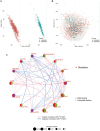
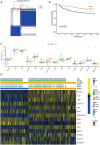
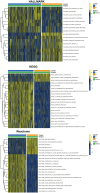


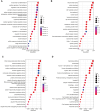
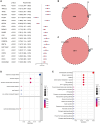



Similar articles
-
Key platelet genes play important roles in predicting the prognosis of sepsis.Sci Rep. 2024 Oct 9;14(1):23530. doi: 10.1038/s41598-024-74052-w. Sci Rep. 2024. PMID: 39384856 Free PMC article.
-
Integrating Bulk and Single-Cell RNA Sequencing Reveals Heterogeneity, Tumor Microenvironment, and Immunotherapeutic Efficacy Based on Sialylation-Related Genes in Bladder Cancer.J Inflamm Res. 2023 Aug 14;16:3399-3417. doi: 10.2147/JIR.S418433. eCollection 2023. J Inflamm Res. 2023. PMID: 37600224 Free PMC article.
-
Contribution of prognostic ferroptosis-related subtypes classification and hub genes of sepsis.Transpl Immunol. 2022 Oct;74:101660. doi: 10.1016/j.trim.2022.101660. Epub 2022 Jul 2. Transpl Immunol. 2022. PMID: 35787932
-
Comprehensive analysis of scRNA-Seq and bulk RNA-Seq reveals dynamic changes in the tumor immune microenvironment of bladder cancer and establishes a prognostic model.J Transl Med. 2023 Mar 27;21(1):223. doi: 10.1186/s12967-023-04056-z. J Transl Med. 2023. PMID: 36973787 Free PMC article.
-
Prognostic stratification of sepsis through DNA damage response based RiskScore system: insights from single-cell RNA-sequencing and transcriptomic profiling.Front Immunol. 2024 Feb 9;15:1345321. doi: 10.3389/fimmu.2024.1345321. eCollection 2024. Front Immunol. 2024. PMID: 38404591 Free PMC article.
Cited by
-
Identification of Hub Genes and Key Pathways Associated with Sepsis Progression Using Weighted Gene Co-Expression Network Analysis and Machine Learning.Int J Mol Sci. 2025 May 7;26(9):4433. doi: 10.3390/ijms26094433. Int J Mol Sci. 2025. PMID: 40362669 Free PMC article.
-
Decoding the Tumor Microenvironment of Myoepithelial Cells in Triple-Negative Breast Cancer Through Single-Cell and Transcriptomic Sequencing and Establishing a Prognostic Model Based on Key Myoepithelial Cell Genes.Int J Genomics. 2025 May 6;2025:6454413. doi: 10.1155/ijog/6454413. eCollection 2025. Int J Genomics. 2025. PMID: 40365116 Free PMC article.
-
Comprehensive Analysis of Sialylation-Related Gene Profiles and Their Impact on the Immune Microenvironment in Periodontitis.Inflammation. 2025 Aug;48(4):2087-2104. doi: 10.1007/s10753-024-02177-1. Epub 2024 Nov 29. Inflammation. 2025. PMID: 39609348
-
Identification of Glycolysis-Related Signature and Molecular Subtypes in Child Sepsis Through Machine Learning and Consensus Clustering: Implications for Diagnosis and Therapeutics.Mol Biotechnol. 2025 Feb 20. doi: 10.1007/s12033-025-01379-8. Online ahead of print. Mol Biotechnol. 2025. PMID: 39976858
References
MeSH terms
Substances
Grants and funding
LinkOut - more resources
Full Text Sources
Medical
Miscellaneous

